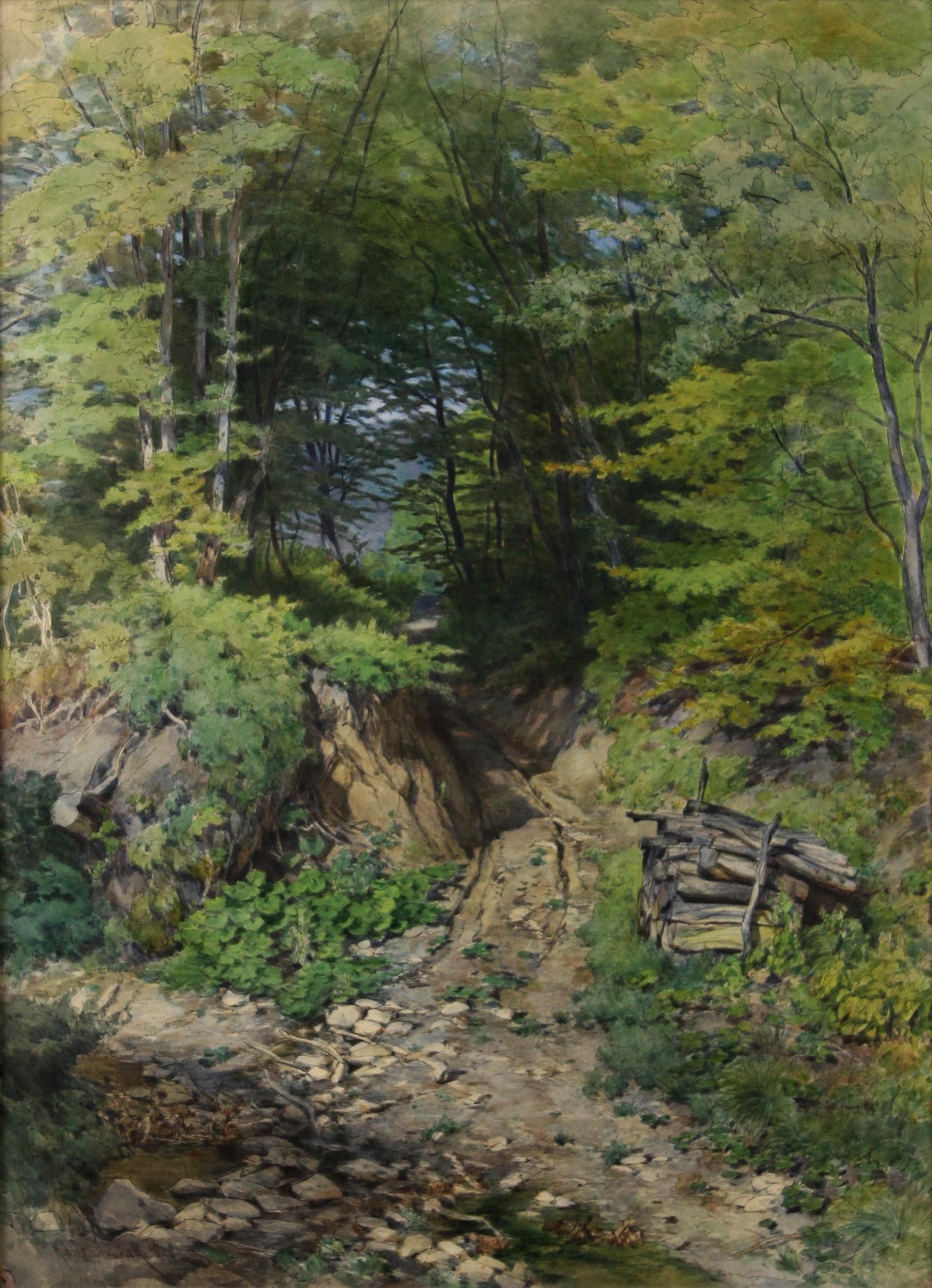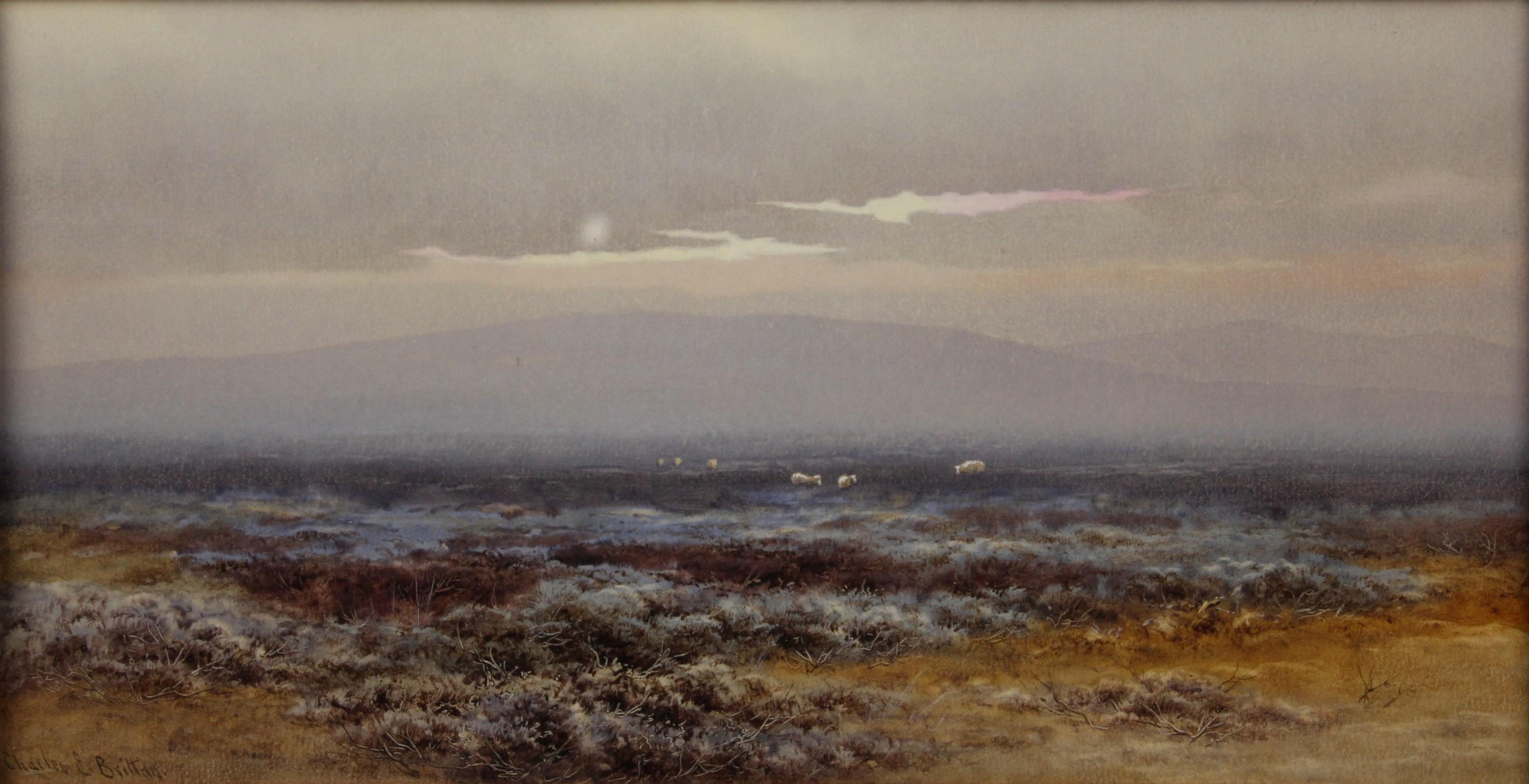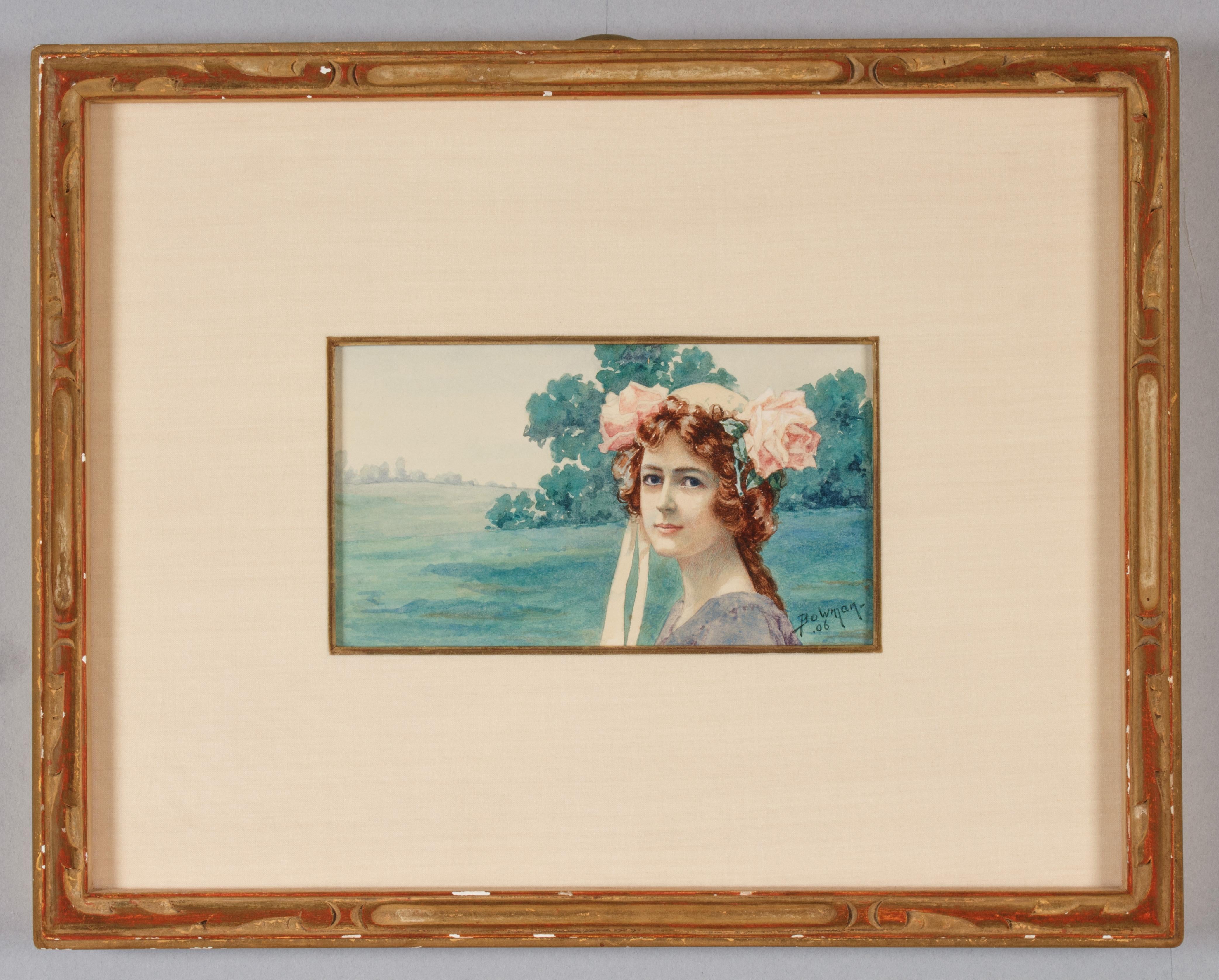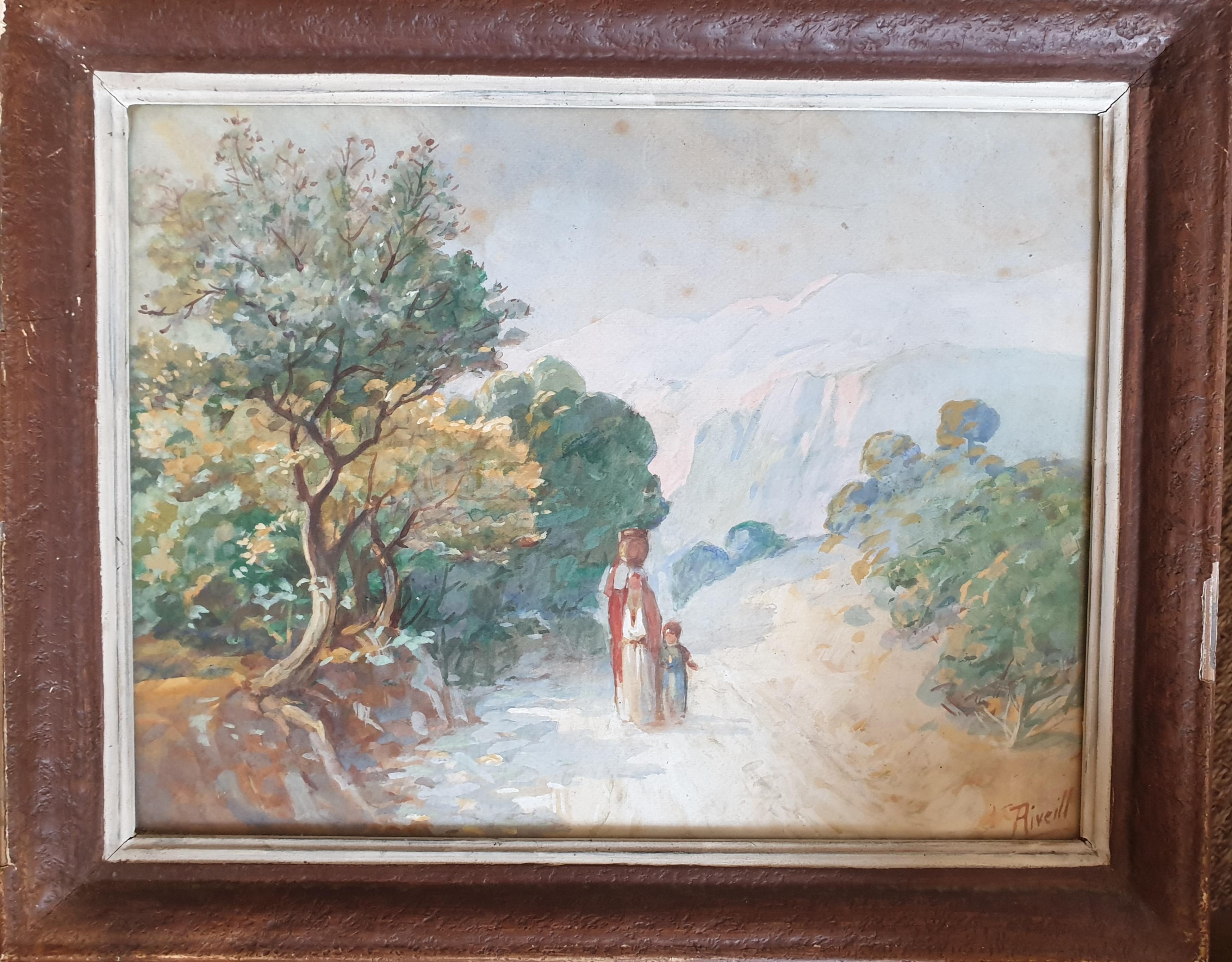Items Similar to Red blooming war landscape with dead soldier - Bleeding flowers -
Want more images or videos?
Request additional images or videos from the seller
1 of 8
Johannes HaenschRed blooming war landscape with dead soldier - Bleeding flowers -1918
1918
About the Item
Johannes Friedrich Heinrich Hänsch (1875-1945), Red blooming war landscape with dead soldier, 1918. Watercolor and gouache on paper, 15 x 24.5 cm (image), 27 x 37 cm (sheet size / frame), monogrammed and dated "19JH18" at lower left.
- Paper slightly darkened
About the artwork
Despite the relatively small format, the watercolor with an internal frame depicts a panoramic view of a flat landscape stretching to the horizon. As far as the eye can see, the poppies bloom in flaming red. The flowers are not rendered individually, however, creating an almost cohesive red surface. The bright red is interspersed with vegetal green. A complementary contrast that creates an intense color effect. In this color contrast, a white area breaks through from the middle ground, widening towards the foreground and surrounding a brown hole. Next to it, in blue, is the actual protagonist of the painting, the first thing that catches the eye: a dead soldier. Next to him is his helmet, revealing the empty interior. The brown, hollow shape corresponds to the hole in the ground. A shell funnel is surrounded by bright ash, which, like the inverted helmet, becomes a sign of death. The soldier's arms point to the funnel, while the empty helmet paraphrases the calotte of the skull and, like the funnel, thematizes the empty darkness of death.
The soldier's body, however, is intact and not - as in Otto Dix's triptych "The War" - a dismembered corpse. Instead, Johannes Hänsch activates the landscape, especially the color, to illustrate a blooming landscape of death that extends from the shell funnel in the foreground to the rising column of smoke on the horizon. If the soldier's body is intact, the tangle of barbed wire emblematically placed over the empty helmet also appears tattered. On the right side of the picture, the barbed wire even seems to stretch its arms to the sky in horror. Against the background of this allegory, the content of the bright red also becomes clear: the landscape is drenched in blood, literally a sea of blood, and the single unknown soldier stands pars pro toto for all those who died on the battlefield. Dying in war is not dying in community, but in solitude. In order to emphasize the isolation in death, Johannes Hänsch has set the blue of the soldier in the axis given by his body in the middle ground of the picture into the red sea.
A master of landscape painting, Hänsch succeeds in creating a natural-looking landscape allegory that illustrates the horror and death of war, without depicting the brutality of war itself. This singular 'war memorial' of the unknown soldier is the opposite of heroization and yet the dignity of the deceased soldier is preserved through the integrity of his body.
About the artist
As the son of the sculptor Adolf Haensch, the young Johannes received his first artistic training in his father's Berlin studio. However, he eventually decided to become a painter, and in 1897 he entered the Berlin Academy of Arts. He initially studied under Paul Vorgang and Eugen Bracht, and was particularly influenced by Bracht's increasingly colourful landscape painting. In 1901 he moved to the class of Friedrich Kallmorgen, with whom he spent several weeks on excursions into nature. In 1905 he became a master pupil of Albert Hertel, who taught him watercolour painting.
From 1903 to 1933 he exhibited annually at the Great Berlin Art Exhibition, the exhibitions of the Berlin Artists' Association and the Munich Glaspalast. In 1905 he was awarded the Carl Blechen Prize. From 1917 until his death in 1945 he spent every year in Silesia, where he rented a studio in Seitendorf an der Katzbach. He also travelled almost every year to paint in the Ore Mountains, to Merano and to the North and Baltic Sea. But he also remained faithful to the Brandenburg landscape, which he - along with Walter Leistikow - painted in a completely new way, earning him the nickname "painter of the Märkische landscape".
Selected Bibliography
Barbara Maennig: Landschaften des Berliner Meisterschülers Johannes Hänsch (1875-1945). Ein Weg zur deutschen Landschaftsmalerei im Spannungsfeld akademischer Lehre und künstlerischer Ansätze der Moderne, Berlin 2003.
Jelena Jamaikina (Hrsg.): Wanderungen durch die Mark. Der Maler Johannes Hänsch 1875-1945, Schwielowsee 2015.
Alexander Römer (Hrsg.): Zwischen Meeresbrandung und Wolkentreiben. Johannes Hänsch auf Sylt. Dresden 2017.
Richard Beetz: Johannes Hänsch in Schlesien - Der Berliner Landschaftsmaler und seine zweite Heimat, Schwielowsee 2021.
Thank you for your interest! I hope I have been able to explain to you the special character of the artwork. If you have any questions of any kind, please feel free to contact me.
I wish you many more discoveries in the realm of art,
Dr Martin Kirves
GERMAN VERSION
Johannes Friedrich Heinrich Hänsch (1875-1945), Rot blühende Kriegslandschaft mit totem Soldaten, 1918. Aquarell und Gouache auf Papier, 15 x 24,5 cm (Darstellung), 27 x 37 cm (Blattgröße / Rahmen), links unten monogrammiert und datiert „19JH18“.
- Papier leicht nachgedunkelt
zum Werk
Trotz des relativ kleinen Formats veranschaulicht das mit einem Binnenrahmen versehene Aquarell panoramaartig eine bis zum Horizont reichende flache Landschaft. So weit das Auge reicht blüht der Mohn in flammendem Rot. Dabei sind die Blüten allerdings nicht einzeln herausgearbeitet, wodurch eine nahezu zusammenhänge rote Fläche entsteht. Das leuchtende Rot wird vom vegetabilen Grün durchsetzt. Ein Komplementärkontrast, der eine intensive Farbwirkung erzeugt. In diesen Farbkontrast hinein bricht sich vom Mittelgrund her ein weißes Areal Bahn, das zum Bildvordergrund hin breiter wird und ein braunes Loch umgibt. In Blau gehalten liegt daneben der eigentliche Protagonist des Bildes, der bei der Betrachtung als erstes ins Auge fällt: Ein toter Soldat. Neben ihm ist sein Helm zu sehen, der das leere Innere offenbart. Die braune Hohlform korrespondiert mit dem Loch im Boden. Ein von heller Asche umgebener Granattrichter, der – wie der umgekehrte Helm – zum Zeichen des Todes wird. Die Arme des Soldaten weisen auf den Trichter, während der leere Helm die Schädelkalotte paraphrasiert und, wie der Trichter, das leere Dunkel des Todes thematisiert.
Der Körper des Soldaten ist allerdings unversehrt und nicht – wie bei Otto Dix' Triptychon „Der Krieg“ – ein zerstückelter Kadaver. Stattdessen aktiviert Johannes Hänsch die Landschaft und dabei insbesondere die Farbigkeit, um eine blühende Todeslandschaft zu veranschaulichen, die vom Granatrichter vorne bis zur aufsteigenden Rauchsäule am Horizont reicht. Ist der Körper des Soldaten unversehrt, so wirkt der emblematisch auch über den leeren Helm gesetzte Stacheldrahtverhau wie zerfetzt. Rechts im Bild scheint der Stacheldraht gar vor Entsetzen ‚die Arme‘ zum Himmel auszustrecken. Vor dem Hintergrund dieser Allegorie wird auch der Gehalt des leuchtenden Rots deutlich: Die Landschaft ist blutdurchtränkt, förmlich ein Meer aus Blut und der einzelne unbekannte Soldat steht pars pro toto für alle auf dem Schlachtfeld Gefallenen. Das Sterben im Krieg ist kein Sterben in Gemeinschaft, sondern in Einsamkeit. Um die Vereinzelung im Tod hervorzugeben, hat Johannes Hänsch das Blau des Soldaten in der von seinem Körper vorgegebenen Achse im Bildmittelgrund in das rote Meer hineingesetzt.
Als Meister der Landschafsmalerei gelingt es Hänsch eine ganz natürlich wirkende Landschaftsallegorie zu kreieren, die den Schrecken und das Sterben des Krieges veranschaulicht, ganz ohne die Brutalität des Krieges selbst darzustellen. Dieses singuläre ‚Kriegerdenkmal‘ des unbekannten Soldaten ist das Gegenteil einer Heroisierung und dennoch bleibt die Würde des verstorbenen Soldaten durch die Unversehrtheit seines Körpers gewahrt.
zum Künstler
Als Sohn des Bildhauers Adolf Hänsch erhält der junge Johannes seine erste künstlerische Ausbildung im Berliner Atelier seines Vaters. Er entscheidet sich schließlich jedoch Maler zu werden und nimmt 1897 das Studium an der Berliner Akademie der Künste auf. Zunächst studiert er bei Paul Vorgang und Eugen Bracht, wobei er besonders von der zusehends an der Farbe orientierten Landschaftsmalerei Eugen Brachts profitiert. Anschließt wechselt er 1901 in die Klasse Friedrich Kallmorgens, mit der er mehrwöchige Exkursionen in die Natur unternimmt. 1905 wird er schließlich Meisterschüler Albert Hertels, bei dem er die Kunst des Aquarellierens erlernt.
Bereits ab 1903 beschickt er bis 1933 jährlich die Große Berliner Kunstausstellung, die Ausstellungen des Vereins Berliner Künstler und den Münchner Glaspalast. 1905 wird er mit dem Carl-Blechen-Preis geehrt. Von 1917 bis zu seinem Todesjahr 1945 hält er sich in jährlich in Schlesien auf, wo er in Seitendorf an der Katzbach ein Atelier angemietet hat. Ebenfalls nahezu jährlich reist er zum Malen ins Erzgebirge, nach Meran und an die Nord- und Ostsee. Er bleibt aber auch der Brandenburger Landschaft treu, die er – parallel mit Walter Leistikow – künstlerisch ganz neu ins Bild setzt, was ihm den Beinamen „Maler der märkischen Landschaft“ eingetragen hat.
Auswahlbibliographie
Barbara Maennig: Landschaften des Berliner Meisterschülers Johannes Hänsch (1875-1945). Ein Weg zur deutschen Landschaftsmalerei im Spannungsfeld akademischer Lehre und künstlerischer Ansätze der Moderne, Berlin 2003.
Jelena Jamaikina (Hrsg.): Wanderungen durch die Mark. Der Maler Johannes Hänsch 1875-1945, Schwielowsee 2015.
Alexander Römer (Hrsg.): Zwischen Meeresbrandung und Wolkentreiben. Johannes Hänsch auf Sylt. Dresden 2017.
Richard Beetz: Johannes Hänsch in Schlesien - Der Berliner Landschaftsmaler und seine zweite Heimat, Schwielowsee 2021.
Vielen Dank für Ihr Interesse! Ich hoffe, ich habe Ihnen den besonderen Charakter des Kunstwerks näherbringen können. Bei Fragen jeglicher Art können Sie mich gerne kontaktieren.
Ich wünsche Ihnen noch viele Entdeckungen im Reich der Kunst,
Dr. Martin Kirves
- Creator:Johannes Haensch (1875 - 1945, German)
- Creation Year:1918
- Dimensions:Height: 5.91 in (15 cm)Width: 9.65 in (24.5 cm)
- Medium:
- Movement & Style:
- Period:
- Condition:
- Gallery Location:Berlin, DE
- Reference Number:1stDibs: LU2438212304512

About the Seller
5.0
Vetted Seller
These experienced sellers undergo a comprehensive evaluation by our team of in-house experts.
Established in 2014
1stDibs seller since 2023
7 sales on 1stDibs
Typical response time: 6 hours
- ShippingRetrieving quote...Ships From: Berlin, Germany
- Return PolicyA return for this item may be initiated within 14 days of delivery.
More From This SellerView All
- Shady hollow way - Into the heart of the forest -By Hans DvoràkLocated in Berlin, DEHans Dvořák (19th century). Shady hollow way in a sunny forest. Watercolour and pen-and-ink drawing, 58.5 x 43 cm (visible size), 70 x 55.5 cm (frame), signed and dated "Hans Dvořák ...Category
1880s Realist Landscape Drawings and Watercolors
MaterialsWatercolor
- High Moorland Landscape in the fog - The world as a transcendent phenomenon -Located in Berlin, DECharles Edward Brittan Jr (1870 Plymouth - 1949). High moor landscape in the fog. Gouache, signed at lower left "Charles E. Brittan", 18 x 34.5 cm (passepartout), 45 x 62 cm (frame)....Category
Early 20th Century Realist Landscape Drawings and Watercolors
MaterialsWatercolor
- Wettersteinkamm - The blue of the mountains -Located in Berlin, DEAdalbert Holzer (1881 Munich - 1966 Munich). Wettersteinkamm. Watercolour, 29 x 34.5 cm (visible size), 37.5 x 43 cm (frame), signed and dated at lower right 'ADALBERT HOLZER [19]23'. Framed behind glass. Frame shows signs of wear. - The blue of the mountains - About the artwork The Wetterstein ridge is revealed to the viewer from a gentle, snow-covered hill. In contrast to conventional depictions of mountains, the painting is composed entirely of shades of blue, which condense into the blue-grey of the rock or fade into the white of the snow. As a complementary colour to the blue, Holzer virtuously activates the ochre ground. The uniform yet exciting polarity of the colours emphasises the massive majesty of the mountains and at the same time underlines the special character of the Wetterstein ridge. Holzer transferred the translucency of glass painting, in which he was originally trained, to watercolour and developed a pictorial language related to the art of Ferdinand Hodler, which earned him the nickname 'Master of Blue' and led to the appreciation of his watercolours in particular. About the artist After an apprenticeship as a stained glass painter at the Kunstgewerbeschule, Adalbert Holzer studied at the Munich Art Academy under Carl von Marr...Category
1920s Realist Landscape Drawings and Watercolors
MaterialsWatercolor
- Wind Dodgers at the Baltic SeaLocated in Berlin, DETheodor Scheerbaum (1897 Reichenbach im Vogtland), Wind Dodgers at the Baltic Sea. Watercolor on strong yellowish grained paper, 44 x 56 cm, signed by hand "Th[eodor] Scheerbaum" at ...Category
1950s Realist Landscape Drawings and Watercolors
MaterialsWatercolor
- Evening Cottage Scene / - Somewhere in Nowhere -Located in Berlin, DEArthur Claude Strachan (1865 Edinburgh - 1954 Minehead), Evening Cottage Scene. Watercolor on paper, mounted, 28 x 46 cm (visible size), 48 x 65 cm (fra...Category
Early 1900s Realist Landscape Drawings and Watercolors
MaterialsPaper
- The Ruins of St. Clement's Church in Visby, Sweden / - Real romanticism -Located in Berlin, DEOtto Günther-Naumburg (1856-1941), The Ruins of St. Clement's Church in Visby, Sweden. Watercolor and ink, heightened with white, on sand-colored paper, mounted on cardboard, 33 x 24...Category
Early 20th Century Realist Landscape Drawings and Watercolors
MaterialsPaper
You May Also Like
- Watercolor Portrait of a Girl with Roses signed Bowman 1906Located in Philadelphia, PAUnknown Artist (Bowman) (early twentieth century) Girl with Roses Watercolor on paper, 5 x 8 inches Framed: 13 x 16 inches Signed and dated at lower right: “Bowman/.06”Category
Early 1900s Realist Landscape Drawings and Watercolors
MaterialsPaper, Watercolor
- The Chestnut Vendor: an early 20th century Italian watercolor signed A.MattoliniLocated in Philadelphia, PAA. Mattolini (Italian, early twentieth century) The Chestnut Vendor Watercolor on paper, 12 3/4 X 9 inches Signed at lower left: “A Mattolini”Category
Early 20th Century Realist Figurative Drawings and Watercolors
MaterialsWatercolor, Paper
- The Watercarrier, Orientalist Watercolour.Located in Cotignac, FREarly 20th century orientalist watercolour on paper by Aiveill, signed bottom right. In art history, Orientalism is the imitation or depiction ...Category
Early 20th Century Realist Landscape Drawings and Watercolors
MaterialsPaper, Watercolor, Gouache
- Notre-Dame de Paris. Paper, watercolor, 26.5x18 cmBy Edward NevilLocated in Riga, LVEdward Nevil ( 1813 – 1901 ) Notre-Dame de Paris. Paper, watercolor, 26.5x18 cmCategory
Mid-19th Century Realist Landscape Drawings and Watercolors
MaterialsPaper, Watercolor
- Sunset Sailors is a Watercolor by Swedish Artist Carl L Lindqvist, Painted 1898Located in Stockholm, SEDiscover this watercolor "Sunset Sailors" by Carl L. Lindqvist (1856-1941). Step into the enchanting world of the Swedish artist Carl L. Lindqvist with his captivating watercolor pa...Category
1890s Realist Landscape Drawings and Watercolors
MaterialsWatercolor
- Quiet Contemplation: Rural Serenity in Hagborg's WatercolorBy August HagborgLocated in Stockholm, SEThe artwork we present is a rare watercolor by the distinguished Swedish artist August Hagborg, painted in the later part of his career between 1910 and 1920. This watercolour is a departure from Hagborg's often-seen beach scenes with mussel pickers and instead offers a glimpse into a serene, pastoral moment. The scene is set against a timber house, with a man and a woman standing alongside, their gazes directed away from the viewer, which invites contemplation about the story behind their distant stares. Watercolors by Hagborg are rare, making this piece particularly special. Its fine details suggest a mastery of the medium, likely honed over the years of his extensive career. A written letter from Göteborgs Konstmuseum, dated to the 1940s, suggests a later date for this piece. August Hagborg, born on May 26, 1852, in Gothenburg and passed away on April 30, 1921, in Paris, was a renowned figure in the art world. His education at the Royal Swedish Academy of Arts in Stockholm from 1871 to 1874 placed him among peers who would rise to prominence, such as Carl Larsson and Anders Zorn. Moving to Paris in the fall of 1875, Hagborg initially painted within the costume genre before finding his niche in coastal landscapes that garnered him accolades and recognition. Hagborg's success was punctuated by his 1879 painting...Category
1910s Realist Landscape Drawings and Watercolors
MaterialsWatercolor
Recently Viewed
View AllMore Ways To Browse
Marcel Roche On Sale
Vintage Circus Showgirl
Vintage Hershey Chocolate
W E B Dubois
W M Birchall
Walter Chin
Zygmunt Menkes
22k Gold Watches For Womens
Al Hirschfeld Defiant
Alice In Wonderland Tile
Andree Marie Belin Delzant
Andy Hammerstein
Antique Teddybear
Antique Teddybears
Appalachian Trail Map
Augusta Hoffman Studio
Augusta Hoffman
Betty Ball On Sale




